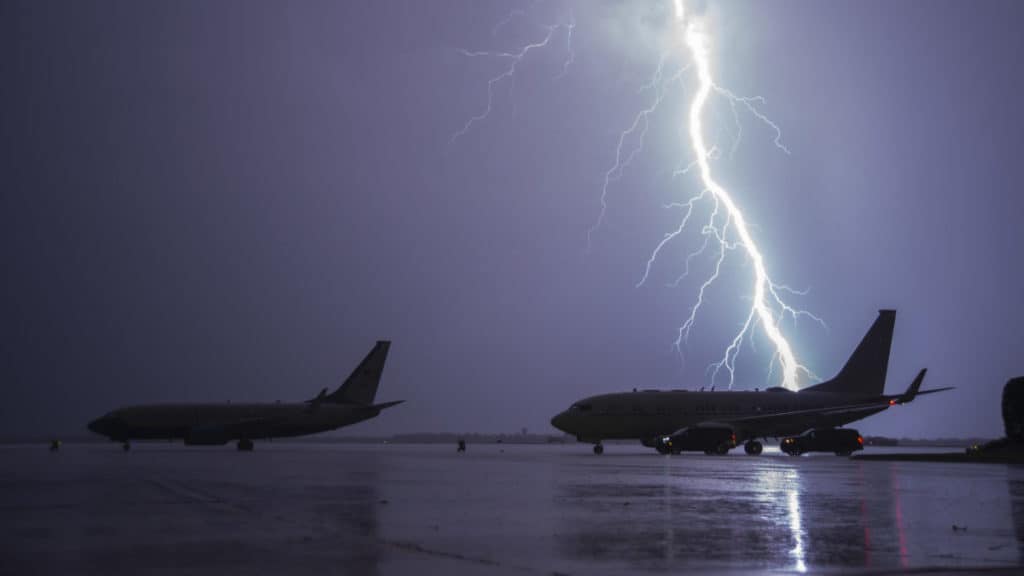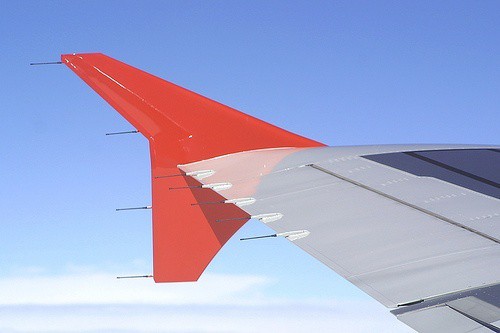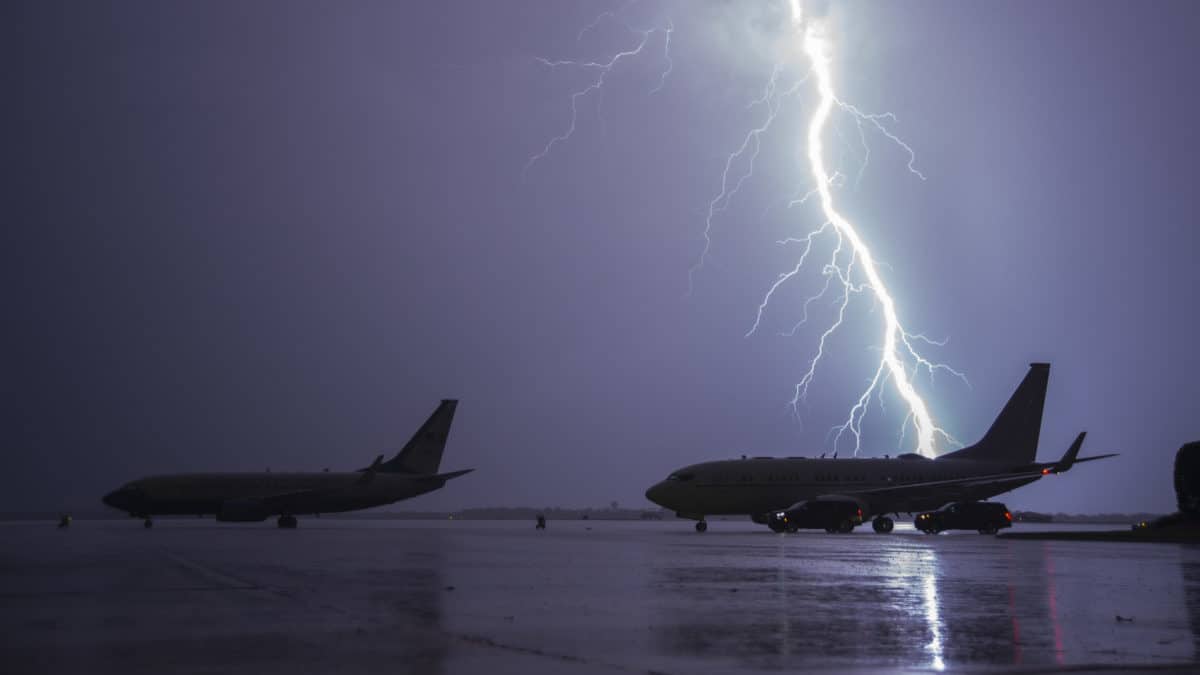
Most passengers would concur that flying in the vicinity of thunderstorms can be a nerve-racking experience, especially during a climb-out or descent through stormy skies. But while turbulence caused by such storms can surely be gut-wrenching, it’s the accompanying bright bolts of lightning that really gets our attention.
One of the most common meteorological events, experts estimate that there are 100 lightning strikes worldwide every second (that’s 25 million strikes annually), with about 80 percent of these being cloud-to-cloud strikes.
The overwhelming majority of cloud-to-cloud lightning strikes occur between 5,000 and 15,000 feet, so aircraft are most at risk during climb out and descent in stormy conditions. This makes the likelihood of encountering a lightning strike much more probable for an aircraft, than for objects on the ground.
Modern airplanes are designed to help dissipate lightning strikes using bonding cables throughout the fuselage, copper mesh woven into composite panels, electrically isolated avionic racks, and shielded wiring. These techniques help divert current flow from a strike around and back out of the aircraft.
Let’s examine how aircraft, both small and large, handle lightning during flight operations.
How Do Commercial Transport Aircraft Handle Lightning?
The fact of the matter is that airliners do get struck by lightning, no matter how much the pilots try to avoid it. In fact, lightning strikes happen on average at least once per year to each aircraft in service.
Thankfully, there is a series of FAA-mandated lightning certification tests to ensure that if/when an aircraft is struck by lightning, the passengers, crew, as well as the plane’s fuel and flight systems are protected from significant damage that could put a flight in danger.
Aluminum is a strong, lightweight, superb conductor of electricity that comprises the ‘skin’, or outer shell of most modern aircraft. If lightning does strike an aircraft, usually on the nose, wingtips, or tail rudder, the electric current passes from the strike point, through the aircraft, and back out via another prominent point.
But how do protective systems devised by aviation engineers work?
A second skin inside of the outer shell protects the cabin and other interior compartments including any internal electronics (avionics/flight systems in particular). This is a metal mesh that surrounds the aircraft’s interior that is then enveloped in silicone.
The electrical charge from lightning strikes is then channeled along this mesh on the outer side of the plane, much like a Faraday Cage, which is used to block electromagnetic charges from entering the cabin itself. Discovered in 1836 by scientist Michael Faraday, this invention still has a myriad of uses for various industries almost two centuries later.
To provide additional protection to avionics, instruments, and flight controls, all of which are essential to flight safety, engineers also install bundles of shielded wiring throughout the airplane, as well as additional wire mesh, metallic diverter strips, and other metal or composite-based items.
These additions help to provide an easier path for a lightning strike to pass through the aircraft while keeping the electrical systems safe. Think of them like a freeway around a large city.
Commercial aircraft and private jets are also outfitted with static discharge wicks which are designed to remove static electricity while inflight. Take a look during your next flight by looking at the trailing edge of the wings. These wicks look like small sticks pointing towards the rear of the aircraft and play an integral part in protecting an aircraft from lightning.

An aircraft that is statically charged acts like a magnet for lightning. By dissipating the static through the wicks the likelihood of a strike is greatly diminished. This is one of the simplest ways to help minimize lightning strikes and you will find static wicks on pretty much every aircraft primarily assembled using aluminum.
New-generation aircraft like the Boeing 787 and Airbus A350 are manufactured with a much higher percentage of composite materials, including carbon fibers. This results in a lower electrical conductivity of the wings and fuselage.
Since lightning mitigation requires an adequate amount of metal to be part of the aircraft’s exterior, manufacturers have developed processes to add metal fibers into the composite material, thus protecting the aircraft’s outer skin by providing paths for the strike to follow and dissipate from.
Learn More…
Try These Articles:
* Why are Unpainted Aircraft Green or Yellow?
* How Do Airplanes Not Freeze In Flight?
How Do General Aviation Aircraft Handle Lightning?
General aviation aircraft adhere to a separate set of regulations when it comes to lightning mitigation. This is because smaller, private aircraft are not designed for public transportation.
These aircraft are made by companies such as Cessna, Piper, Cirrus, and Beechcraft, offering basic lightning protection for the engines, fuel system, and airframe.
Unlike the larger commercial airliners that are on a route and schedule, general aviation (GA) aircraft have much more flexibility in when and where they can be flown. As a general rule, pilots are taught to divert around thunderstorm cells by at least 20nm. If unable to divert, find a place to land and wait for the storm to pass.
However, there are times when GA aircraft do get struck so aircraft manufacturers still have to provide some lightning mitigation into the aircraft design.
Older, smaller aircraft are less computer-reliant aircraft and constructed with aluminum skins, making them less at risk when it comes to lightning. Much like transport-designed aircraft, if struck by lightning, the electric charge will travel through from nose-to-tail, wingtip-to-wingtip, or another similar way, entering and exiting in a split second.
Because of numerous reports of damage to propellers, wing tips, and navigational aids, engineers have developed, and continue to enhance lightning protection systems for general aviation aircraft.

Join My Newsletter & Get Great Tips, Information and Experiences To Help You Become a Superb Pilot!
Today’s, modern light aircraft are mostly manufactured with fiberglass, or a fiberglass/carbon combination, much like commercial aircraft including the Boeing 787 and Airbus A350.
Because these materials are more susceptible to lightning, following FAA directives, engineers have developed programs that just like the modern airliners include metal foils, or nonwoven metal (aluminum, bronze, and nickel/copper) meshes in layers under the outer skin and throughout the aircraft.
These bonding properties help create a conductive path for lightning to travel around the passenger compartment and fuel systems until it exits the aircraft.
Much of the progress in the development of lightning protection systems for general aviation and commercial aircraft has evolved from NASA and FAA experimentation over the years. The science of lightning mitigation continues to rapidly change, with newer and more efficient systems being designed by teams of atmospheric scientists.
In general, the rule-of-thumb for smaller, private aircraft, is to steer clear of thunderstorms. Period. While they can probably handle a lightning strike without catastrophic consequences, the extreme turbulence often associated with thunderstorms can quickly lead to disaster.
General aviation pilots are aware that turbulence, hail, high winds, and lightning can occur well beyond the clouds that form a storm. I can tell you from experience that a GA pilot will only dabble with a thunderstorm once in their life before they realize just how frightening mother nature can be!
Learn More…
Try These Articles:
* Aviation Weather Information: How do Pilots Get It?
* Birds: How Do Pilots Avoid Them?


